Description
The book that is changing the art materials industry, enabling the artist to choose between well made light fast colours and those that fade or darken. This edition has been expanded to feature some 2,500 colours and all major paint manufacturers. There are many surprises in store for the concerned artist. The most comprehensive guide to artist’s watercolour paints ever published. All leading manufacturers assessed, the pigments that they use fully identified and light fastness examined.
Quote from Joy Turner Luke (Joy is a leading expert in paints, pigments and colour use)
“This is a landmark book for artists. It contains a vast amount of information that is not available elsewhere. No matter how knowledgeable you are as an artist, you are going to be surprised by many of the facts in this book. It is the first to cover the wide range of pigments currently used in artists’ watercolours and will help safeguard your work. The art teacher and artist buying paints have been looking at a giant jigsaw puzzle with most of its pieces missing. Michael Wilcox has supplied those pieces.”

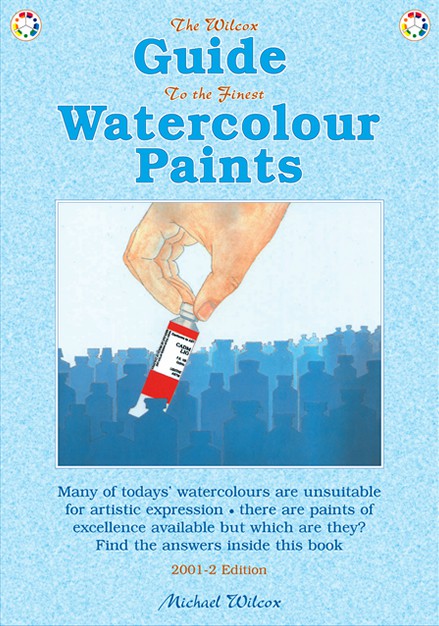
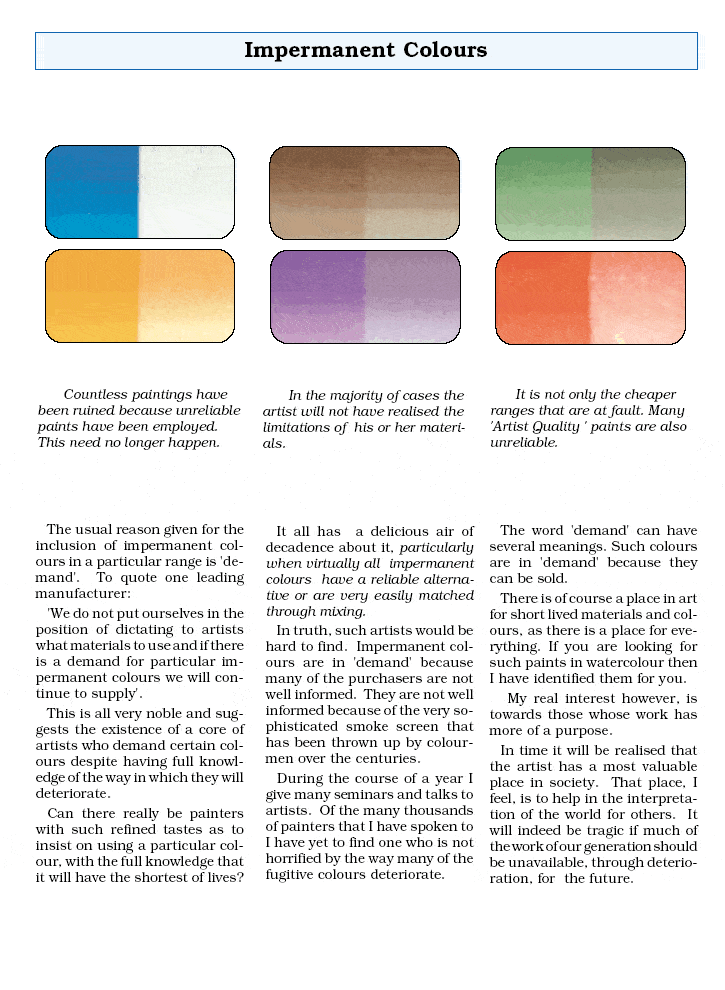
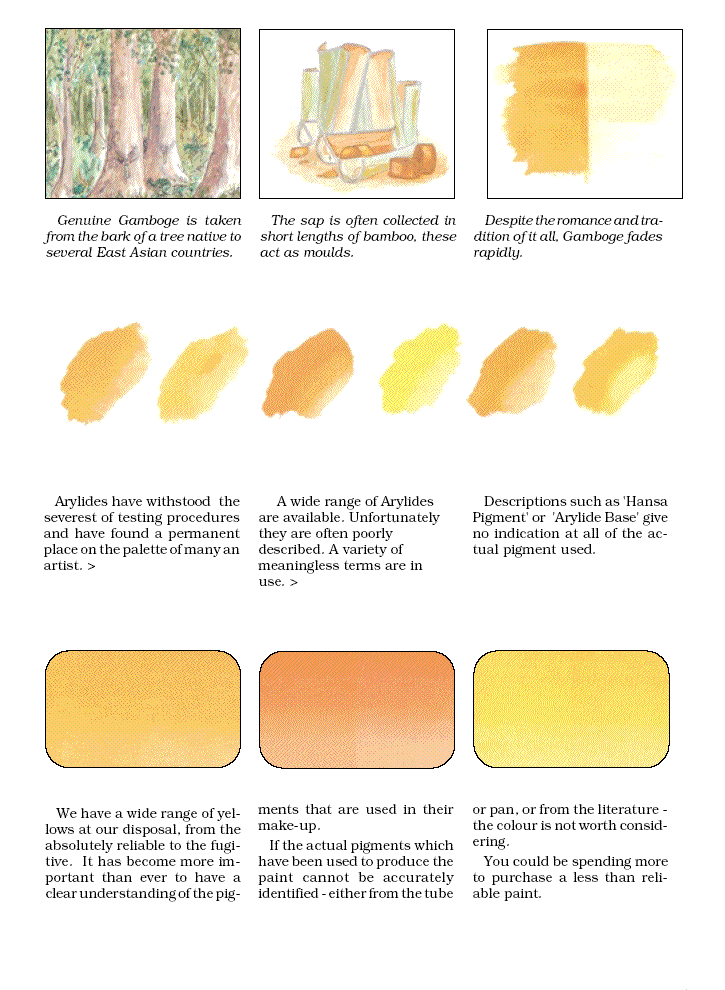
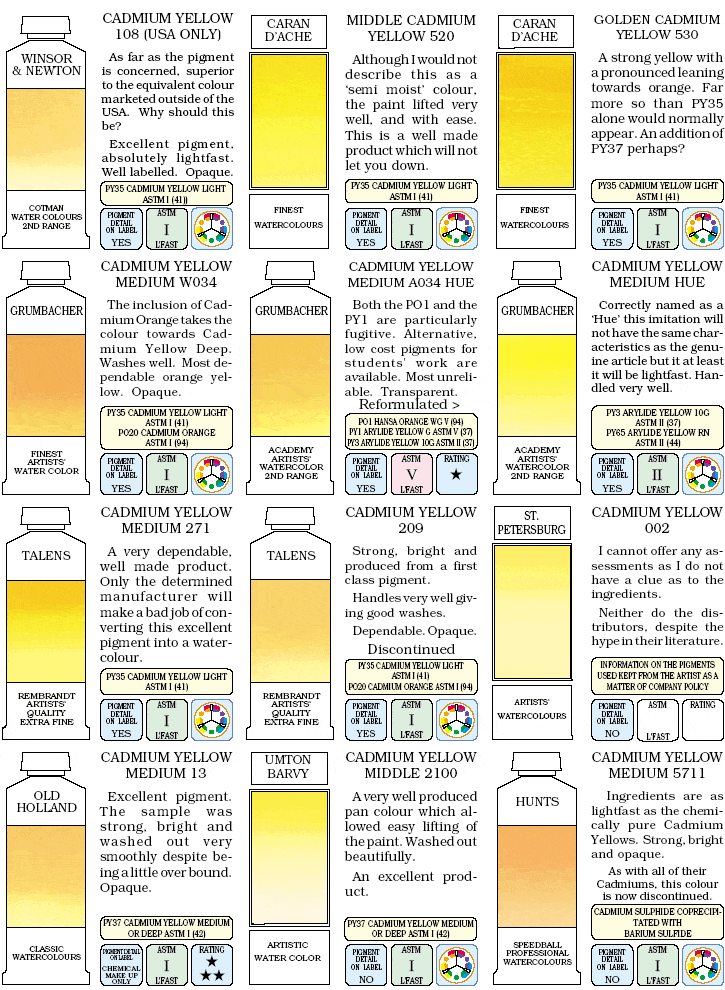
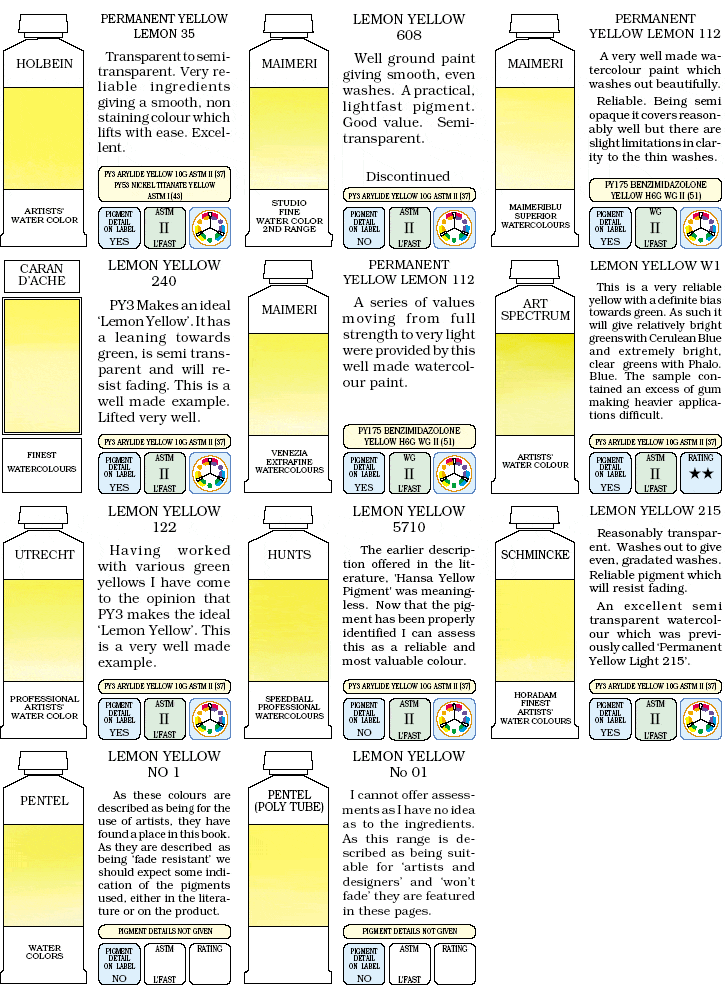
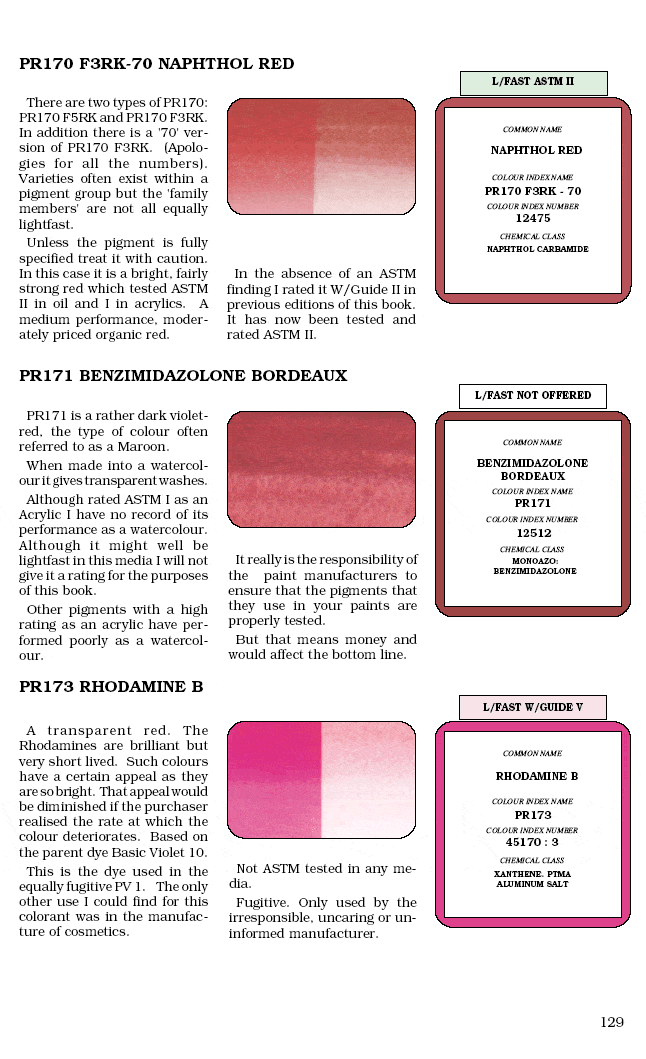
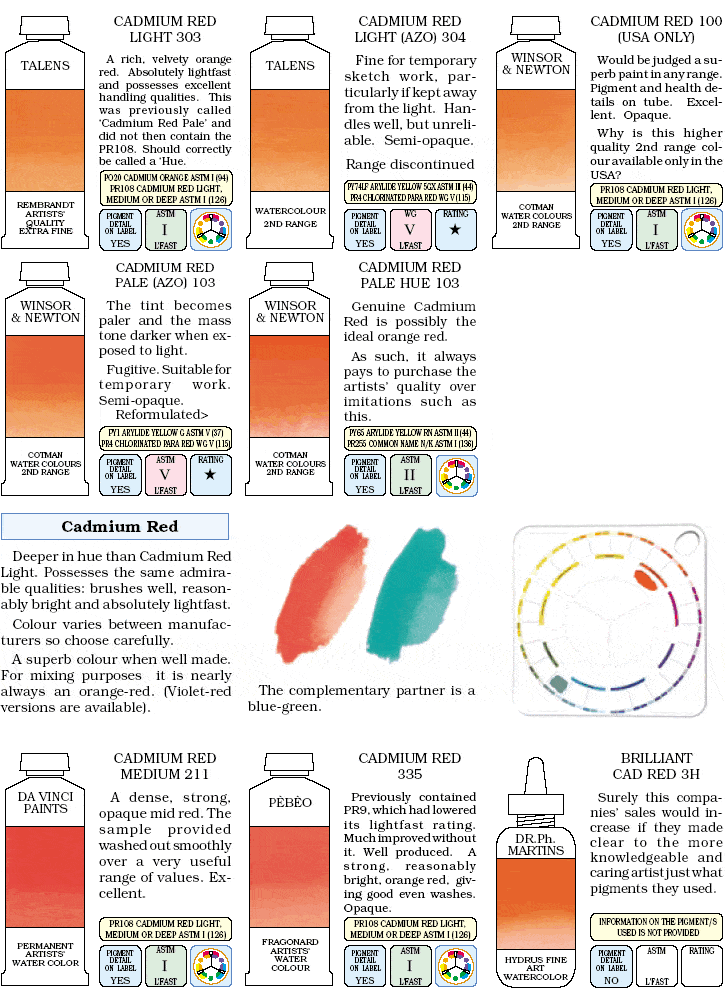
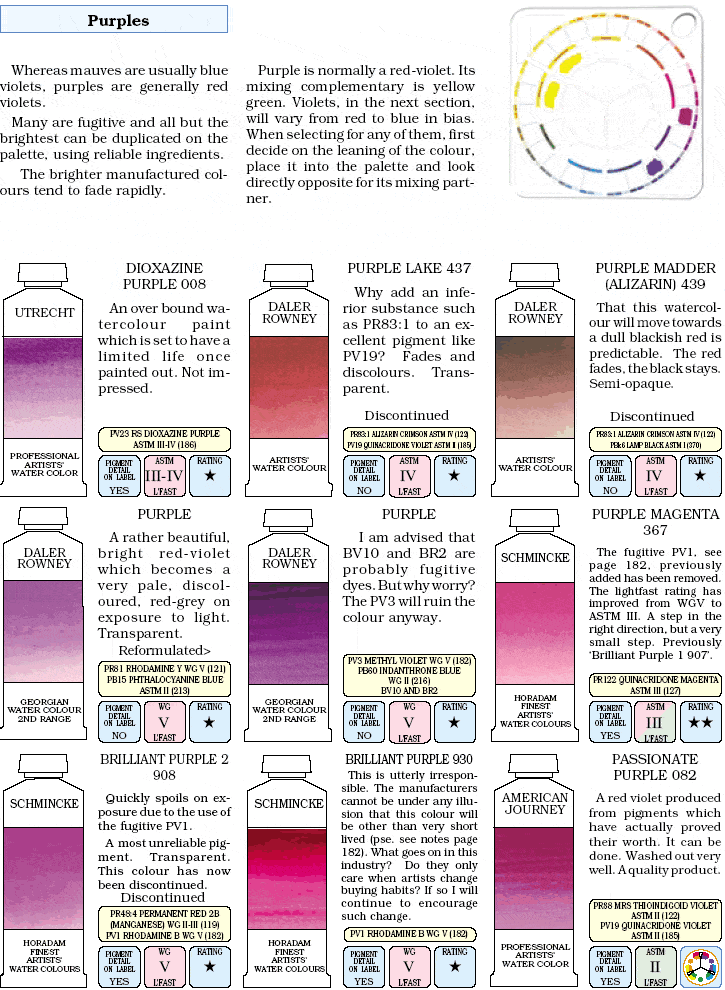
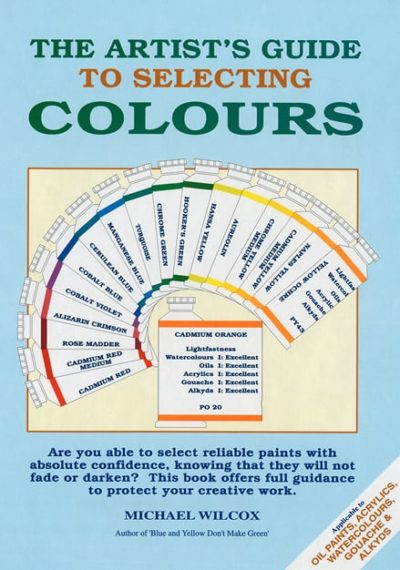
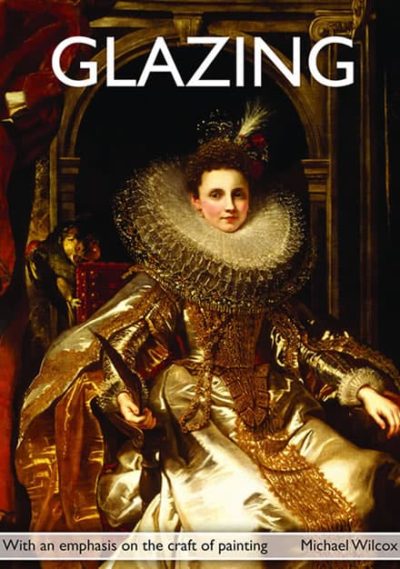
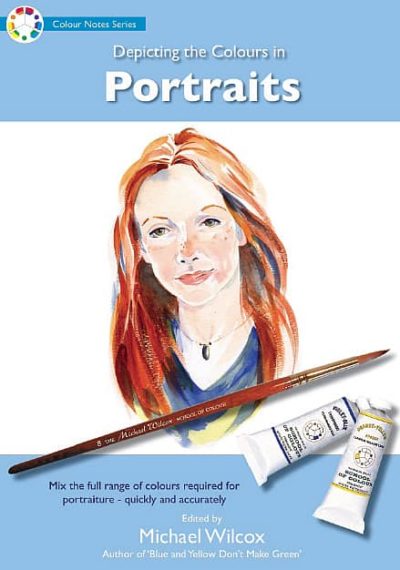
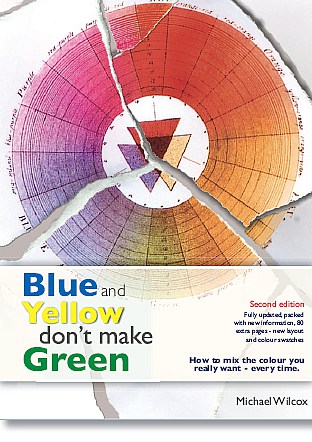
amazon –
The Wilcox Guide to the Best Watercolor Paints
By JRVanBon June 15, 2010
Format: Paperback|Verified Purchase
I wish I had had this book years ago. Some of the paints I have been using just arn’t up to snuff. With this book, I have eliminated paints that fade to bring me to a lasting product for the public as well as my own enjoyment. Why was this information not made available before? This book gives the chemical name for each pigment. PY means pigment yellow, PO is pigment orange, PR pigment red, etc. with the number following. If the pigment number is a poor choice, you will know not to buy or use that number. The author researched many different brands so you can check each. Just because you bought the most expensive brand doesn’t mean they used the best pigment. This should be a staple in every University Painting class. I found this book as a used book at a very reasonable price. If you are at all serious about creating works that stand the test of time, this book is well worth the time and money spent. The only drawback that I see for me is it is a paperback, which I know I will wear out. I will be looking for the next edition, hopefully published in hardback format.
amazon –
A Great Resource
By Julieinca1on April 13, 2012
Format: Paperback|Verified Purchase
In reading through this book, I found a couple of my paints that will not stand up to time in a painting. Even though I might have wasted money on those paints, I can now purchase new paints with the confidence that they are good quality paints. I understand that some companies have improved their paints due to this book and now they are of higher quality, but as a strong basis this book will give me a lot of guidance in purchasing new paints.
amazon –
Great guide for the serious colorist
By sunseton July 25, 2013
Format: Paperback|Verified Purchase
This book is great for serious painters that need to really know more about their paint than just a manufacturer’s name. It gives so much information that it is now my ‘go to’ guide before I purchase any paint.
amazon –
Watercolor Paints
By NCGon October 8, 2013
Format: Paperback|Verified Purchase
I ordered this to better understand what makes a good color good.
I also ordered it to know how to use the nature of the color to it’s
advantage, ie. transparent, non moving, etc. Strong opinions are
expressed in this book but they are well substantiated with facts.
This will be one of my key reference books as I practice my craft.
amazon –
By Amazon Customer on March 27, 2017
Format: Paperback|Verified Purchase
Every watercolorist needs this book!
amazon –
I’m happy to have this reference.
By Jane C. Nowlinon January 12, 2014
Format: Paperback|Verified Purchase
I have had much angst by the fact that not every manufacturer of color is careful or consistent making watercolor. This book helps me decide which color I want to buy in a format that is easy to use and find
amazon –
Great Guide book
By slcgolferon January 2, 2014
Format: Paperback|Verified Purchase
Very good book. It discribes every manufacture of watercolor paint made and each color they produce. Can’t go wrong uing this book.
amazon –
For serious artists
By K. Wohlerson May 9, 2013
Format: Paperback|Verified Purchase
The publication that should be in the hands of every serious watercolorist. This guide has been around for a number of years and gets continuous updates. It takes the poor manufactured colors out of your hands if you chose to follow this guide and I follow it. The manufacturer’s upgrades are listed for the intended colors that were once suspect or worse.
amazon –
The best in watercolor paint information
By Brenda K. Beattyon August 29, 2013
Format: Paperback|Verified Purchase
The book is an excellent guide to quailiy watercolor paint. It is well organized.and indexed. It is a must for all seriuos watercolor artists.
amazon –
Valuable resource
By Amazon Customeron March 25, 2004
Format: Paperback
This exhaustive (not to be confused with exhausting) research-based volume should be mandatory reading for all those artists interested in giving their customers their utmost quality of paint on works of art sold. So many paints are not light-fast, or are ‘fugitive’ (absolutely unreliable), or are packaged by the manufacturer as ‘new’ colors when they are, in fact, only creative blends of basic colors that any artist can create with colors they likely already have. This book, covering many of the watercolor paint producers in the Western world, exposes these flawed paints, but also gives credit where due to the top-notch pigments and their manufacturers. Details of content, health ratings, color-fastness and quality of brush use are easily understood. Fantastic color swatches (before and after exposure to light) are beside each manufacturer’s sample. My only complaint is that this is the only edition available (pub. 1991), as the author said it would be updated periodically, which does not yet appear to have happened. There were only a couple of Quinacridone colors 12 years ago at the time of publication, whereas there are many more now.
amazon –
Invaluable guide to reliable watercolours
By A customeron June 9, 1998
Format: Paperback
I should preface my comments by saying I’m not a watercolour painter although I’m interested in colour and pigments, however this book is still a fascinating read and an invaluable resource for any serious watercolourist – leisure or professional.
The book is broken down into sections on each colour family with exhaustive comments given on colour, density, handling and lightfastness I think. Some of the results are surprising – some colours from ‘reliable’ manufacturers are a big disappointment in one or more of the criteria mentioned above and the occasional colour is simply laughable – read it and see what I mean. Any watercolourist who wants to buy colours he or she can rely on should definitely invest in this book.
Oil and acrylic follow-ups were planned but I’m not sure if they were ever produced. I highly recommend Wilcox’s book “Blue and Yellow Don’t Make Green” as well. Despite the apparently-nonsensical title this is one of the definitive books EVER on colour theory as applied to the real world – not some abstract notion of perfect colours. When you learn about colour bias as explained in this book you will never look back to your days of wondering, “Now how do I mix this colour…?”
amazon –
An Informative Book
By Amazon Customeron December 30, 2001
Format: Paperback
M. Wilcox’s book is a goldmine of information, especially if you are new to watercolor paints. He discusses several topics that are of interest to the artist: discriptions of color on the tubes of paint; individual pigments and what is known of them; and while this is aside from the main topic – a brief history of the individual neutrals, primary & secondary colors. While he doesn’t explain the exact methods of testing for each pigment, he states that he uses the ASTM ratings as far as possible and that his own “controlled” testing is for confirmation purposes and through out the book one can find examples where there were no ratings given with an explanation why. He also states that his own ratings for lightfastness, his ratings in “Box 4” and his written assessments of the paints are “my own assessment and should be treated as such” (pg 14).
I noticed that some color lines were no longer available, he includes details about them because many still have a supply on hand. He also gives descriptions of the various companies and a picture of the tubes of paints and gives some kind of idea the strength of the tubes themselves. While this may not be helpful to some, it was to me. I have neurological problems with my hands and there are certain caps I can open more readily than others. Another part of the book I liked were his “confessions” and admitting that his word was nothing but his own opinions.
The color examples I never paid attention to except generally, because, being an artist (albeit in another area) I realize there is a vast difference in reality and the printed version. On the down side, I found the arrangement of pigments annoying, I think that portion could definately use some rework. Also, annoying – the incorrectly spelled words. Where were the editors? There are some of his deductions that I totally disagreed with, due to the fact that I have used a few watercolors in my monoprints. But I believe that each one of us has his/her own opinion and naturally there will be disagreements about whether this color is good or not. Also, it is possible that a “bad” tube of paint escape the company’s quality control people.
Overall, I think this book is a must read, especially if you are new to the world of pigments. Thumbs Up!
amazon –
If you want to save money buying watercolors, buy this book.
By A customeron August 15, 1998
Format: Paperback
Many “artists” quality colors are very expensive, but you may think you need these and may shy away from the “second range” colors. You’ll change your mind when you read this book. I’ve gotten excellent quality paints and saved money by purchasing specific colors from specific brands using Michael Wilcox’s book. It’s a Consumer Reports for paint buyers. As a scientist as well as an artist, I find this book fascinating. The book is arranged by colors. It clearly covers pigments used by all manufacturers and gives details on the pros and cons of each. Each paint produced by several companies is then covered. A history of pigments used for each color is also given. This book is not only an invaluable buyers and artist’s resource, it is also interesting reading. I recommend it highly.
amazon –
Aren’t all Cadium Reds alike?
By L. Kuusinenon February 18, 2007
Format: Paperback
It is amazing how different the colors are look and behave. Confused by the labeling PB42 or Hue or ASTM I? Why does the same labelings (i.e. PR108) appear on multiple colors? What do those weird names really represent? It makes for interesting reading – the history, the best, and the worst products. I always wondered why some of my watercolors looked grainy. Not all colors by the best manufacturer rate highly. This book looks like a lifelong effort that will save your experimenting forever to find a good Cadium Red color, a member of one of the 10 major color groupings covered.
amazon –
If you do professional watercolour work, buy this book.
By A customeron July 30, 1998
Format: Paperback
This book has revolutionized and reformed the world of watercolour painting. Major, respectable pigmenters have misinformed us in the labelling of their pigments. Now they are held to account. You need to know the information in this book. It will change your painting habits permanently. Wilcox is the Ralph Nader of the world of pigments.
amazon –
By Judy Reedon July 20, 2015
Format: Paperback|Verified Purchase
Good description of pigments, but I wish it could be updated.
amazon –
Invaluable reference–buy before you buy paint!
By Marina E. Michaelson May 25, 2006
Format: Paperback
If you spend hours or days painting a watercolor picture, you are going to want to use the best possible paints. You won’t want to see your painting fade, become blotchy, or otherwise deteriorate due to inferior paint. To prevent just that sort of thing, this reference book attempts to educate you on the pigments used in watercolor paints–their lightfastness especially, but also other qualities. Which pigments will fade or become blotchy over time? Which will stay strong and true? This book does its best to exhaustively answer those questions.
This book has been updated several times. It is due for another update, but since there is no telling when or even if such an update will be produced, it is still so valuable that I highly recommend getting it now before you buy any (more) watercolor paints.
Although I am reading it all the way through (because that’s the kind of person I am), this is not a book to be read, but rather referred to. Let’s say, for example, that you want to replace a red you’ve been using. You would turn to the description of the red pigments, glance through to find the pigments that have been rated highly lightfast by the ASTM (American Society for Testing and Measurement) and that have the color quality you want, then you would turn to the paint reference section to see what brands offer a red using the chosen pigment(s). Even if you cannot find a brand that suits you (and you should be able to), armed with the information in this book, you can go shopping with confidence, checking the paint tubes to make sure they have the pigment you want and not some pigment that will fade and ruin your painting.
For that alone, this book is valuable.
Allow me to address some of the comments other reviewers have made. One reviewer commented that the Da Vinci paints are student grade. I disagree. I’ve tried a number of different brands, and Da Vinci’s artist-grade paints are wonderful–buttery, smooth, and a pleasure to use. (I also like many of Windsor & Newton’s paints.) Yes, Michael Wilcox contracted with Da Vinci to create his own custom line of paints, but, as he states in the latest edition of this book, he did that many years after the initial editions in which he had already praised and recommended many of Da Vincis’s paints. And he doesn’t hold back in criticizing many of the Da Vinci student-grade paints, nor does he hold back in praising or criticizing any brand of paint.
I believe that Mr. Wilcox has tried to be as objective as possible, and I also do *not* see any inappropriate pushing of his own line of paints. He has a single very low-key page–at the back of the book!–describing the Michael Wilcox School of Color, which lets you be the judge of whether you want to look into it more. I also haven’t seen any advertisements of his line of paints in the book yet, and, as I said, I’m reading it cover to cover. (I’m in the reds at the moment, though, so I could be wrong, but if the remaining pages follow the pattern already established, I don’t expect to see any such advertisement in the remaining pages.)
Another reviewer said that this book has out-of-date paints (it does) and *doesn’t* reflect reformulations (but it does). Had they read the book (though perhaps they had an older edition), they would have found Mr. Wilcox’s reasons for including discontinued paints. He states that some people may have those older paints still in their supplies, and so he wanted to present that information for those people. If you are a watercolor artist, you know how long paints last. I have tubes I purchased ten years ago. I know artists who have tubes they purchased even longer ago. How valuable it is to be able to read what is in those paints, and possibly avoid using something that will, in the end, disappoint!
He also provides information on old formulas, with an arrow pointing to a new entry on the reformulated paint. Again, including information on both the old and new formulations is valuable. If you are an artist with the old formulation in your supplies, you will want to know that (A) it is perhaps unsuitable and (B) there is a better replacement available for it. Yes, it is possible that there have been even further reformulations since the last edition, but each edition has been keeping up with the times, and I fully expect that, should Mr. Wilcox produce another edition, it will be as up-to-date as possible.
The one valid criticism of this book is that it could be better organized and better edited. DEFINITELY. There are missing words, grammatical errors, punctuation errors, dead-end sentences, orphan sentences, sentence fragments, and so on pretty much on every page. The organization of the material could also be better, and more information on both his testing methods and on the ASTM standards would be greatly appreciated. Mr. Wilcox should perhaps be told that there are copy editors he can hire on a contract basis to copy-edit his works and improve them vastly. Better yet, a developmental editor, who will be more expensive but also more valuable, could help with the organization and content as well.
An alphabetical index of at least all the colors would be great too. A professional indexer could create such.
These are the reasons I gave this book four stars instead of five are (A) the age of the book, (B) the errors, and (C) the need to better organize and expand the content, especially the information on testing standards and methods.
However, flaws aside, this is an enormous work, enormously valuable, with clearly hundreds if not thousands of hours of work put into it, and the information shows that effort.
It should also be mentioned that, before Michael Wilcox published the first edition of this book, whether you would get good paints from even some of the major manufacturers was a hit-or-miss proposition. Many non-lightfast pigments were used, and poor quality paints were created, even by the giants. When this book hit the scene, it had a great deal of positive influence on the watercolor manufacturers. Many of them dropped or reformulated their more questionable paints. That in itself tells you the value of the information in this book. Of course, the ASTM had a lot to do with it too, but without this book pointing out the lack of clothes on the emperor, I am not sure how much weight the ASTM standards alone would have had.
If you are a watercolor artist, do yourself the favor of adding this book to your reference library.
amazon –
An excellent, if eccentric, guide to quality
By A customeron January 16, 2001
Format: Paperback
I just received the 2000-2001 edition of this reference work, and found it fascinating. Wilcox has produced a consumers’ guide to colors, with detailed comments on specific brands and information that can be of great help in color mixing. If you want to know which paints are most colorfast, and how to pick colors to avoid “mud,” this is the book for you. Wilcox DOES have his own Web site–and line of paint… Whether this colors his judgment (sorry, couldn’t resist) or not, I don’t know, but I found the book very helpful in planning not only what paints to buy, but colors to use.
amazon –
Brilliant book for those in the art world interested in …
By Amazon Customeron 6 November 2016
Format: Paperback|Verified Purchase
Brilliant book for those in the art world interested in pigments – count me in! A book I would not wish to be without.
amazon –
Know what you are using.
Essential handbook for any watercolourist. Invaluable information on the properties of paints for artists to ensure that their paintings will last and a great catalogue of the colours available.
By J. M. Williamson (AMAZON – Verified Purchase)
amazon –
A useful book to help you select suitable paints.
This is a book I wish I had bought long ago to help me in selecting lightfast watercolour paints.
It begins with an explanation about the work of the ASTM and with the methods of testing used in the book.
Following this are brief summaries on the product ranges of various paint manufacturers. It would have been helpful had these been presented in alphabetical order, but this is a small point.
The remainder of the book is divided into chapters on colour families: reds, violets, blues, greens, browns, greys, blacks and whites.
For every colour there is a description of each pigment used. As well as its common name, the colour index name and number and chemical class are provided. I found this helpful in aiding me in considering manufacturer colour charts and watercolour paint labels. In addition the benefits and drawbacks of pigments are given where applicable.
The paints produced in the colour family are given with their common names,manufacturer, pigments used and the results of any tests carried out. The information relating to these tests typically includes the way the paint brushes out, the ASTM lightfast rating, whether or not the pigment details are included on the paint label and an overall rating by the Michael Wilcox School of Colour.
Both student and artist’s quality paints are included as are some discontinued paints. However a few of the paints are not given a rating for one reason or another.
I found this book extremely useful. I have to admit that I was disappointed that a few of the pigments I use did not perform well and am actually doing my own lightfast tests on them now. However, at least now, when I need a new colour, I am able to refer to the book before I make a purchase. A big value of the book is that manufacturers are encouraged to keep up or raise their standards of paint production.
By A customer (AMAZON – Verified Purchase)
amazon –
If you want to save money buying watercolors, buy this book.
Many “artists” quality colors are very expensive, but you may think you need these and may shy away from the “second range” colors. You’ll change your mind when you read this book. I’ve gotten excellent quality paints and saved money by purchasing specific colors from specific brands using Michael Wilcox’s book. It’s a Consumer Reports for paint buyers. As a scientist as well as an artist, I find this book fascinating. The book is arranged by colors. It clearly covers pigments used by all manufacturers and gives details on the pros and cons of each. Each paint produced by several companies is then covered. A history of pigments used for each color is also given. This book is not only an invaluable buyers and artist’s resource, it is also interesting reading. I recommend it highly.
By A customer (AMAZON – Verified Purchase)
amazon –
Brilliant book for those in the art world interested in …
Brilliant book for those in the art world interested in pigments – count me in! A book I would not wish to be without.
By Amazon Customer (AMAZON – Verified Purchase)
amazon –
An ultimate guide to choosing and using the finest watercolour paints
The Wilcox guide to “THE FINEST WATERCOLOUR PAINTS” is an absolute must for those dedicated to the Art of producing the finest quality -in terms of paint quality-in their watercolour painting.. Choose a colour you like ( and each colour is examined for its overall functionality). Then choose one of the selected manufacturers -Each paint is then examined for its production quality and paint quality -leaving you to choose for yourself and therefore avoiding exhaustive research when chasing the ideal….Extremely useful book for the dedicates of the ART! 285pps availability..RARE
By mikespacedout (AMAZON – Verified Purchase)